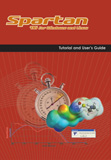|
The Graphical User Interface. Spartan'06 Essential Edition has a single, integrated, easy-to-use GUI. In very little time, one can build/manipulate molecules, run molecular mechanics and quantum chemical calculations, and examine results with Spartan graphics, property boxes, spreadsheets, plots, and text outputs.
|
Organic
|
Accesses a builder for common organic fragments (e.g., "sp3 carbon"), functional groups and rings for easy construction of organic molecules.
|
|
Inorganic
|
Extends building throughout the Periodic Table. Includes groups, rings and a library of common ligands.
|
|
Peptide
|
Accesses a builder of amino acids for construction of polypeptides as a helices, b sheets or in user-defined conformations.
|
|
Nucleotide
|
Accesses a builder of nucleotide bases for construction of single or double stranded DNA or RNA as A or B helices or in user-defined phi/psi angles.
|
|
Substituent
|
A new builder for generating groups of substituted molecules.
|
|
2D Building
|
New seamless access to 2-D building via ChemDraw (must licensed separately from CambridgeSoft).
|
|
Custom
|
Accesses an included (and customizable) library of additional functional groups, rings and ligands.
|
|
Clipboard
|
Cut/paste access to any molecule or molecular fragment which has previously been constructed.
|
|
Import
|
Spartan, SYBYL MOL and MOL2, PDB, MacroModel, smiles, XYZ, SDF, TGF, SKC, CIF, and CDX files.
|
|
Export
|
Spartan, SYBYL MOL and MOL2, PDB, MacroModel, smiles, and XYZ molecule files, graphics as JPG, PNG, and BMP files, animations as AVI files.
|
Spartan includes access to a number of highly useful molecular databases, including: The Spartan Molecular Database, Spartan Reaction Database, Cambridge Structural Database* and Protein Data Bank**.
*CSD must be licensed separately. **PDB access requires internet connectivity.
|
Spartan Molecular Database
|
Access and retrieve/replace constructed or imported structures from a library of > 140,000* molecules, pre-calculated at HF/3-21G and HF/6-31G* theory levels. Retrieved data includes: molecule name, equilibrium geometry, gas-phase energy, estimated (aqueous) solvation energy, HOMO and LUMO energies, dipole moments, electrostatic-fit atomic charges, surface area, polar surface area, volume, weight, symmetry, and spectra data.
* Current release contains over 140,000 molecules (~400,000 structures) -- this number is expected to grow by ~ 25% per year (future releases will include transition states and organometallics). Annual updates available for customers with maintenance.
|
|
Spartan Reaction Database
|
Access to exact and substructure searching of the Spartan Reaction Database of more than 1500 reaction types for providing initial structure guesses for transition state geometry calculations.
|
|
Cambridge Structural Database
|
Accesses the Cambridge Structural Database (CSD)* of over 300,000 experimental X-ray crystal structures for organic and organometallic molecules, together with their literature references. Spartan optionally adds hydrogens and refines hydrogen positions.
*CSD may be licensed from the Cambridge Crystallographic Data Centre or one of its distributors.
|
|
Protein Data Bank
|
Spartan can retrieve (based on PDB ID) entries from RCSB PDB (provided your computer has current internet connectivity). The Protein Data Bank includes more than 30,000 x-ray crystal and NMR structures of proteins and nucleic acids.
|
Computational Methods. Spartan'06 Essential provides a well documented range of computational approaches, including Molecular Mechanics, Semi-Empirical and Hartree-Fock Molecular Orbital Theory. All methods are easily accessed via Spartan's seamless graphical interface.
|
Molecular Mechanics
|
Molecular mechanics is presently the only practical method for calculations on very large molecules or for conformational searching on molecules with a large number of degrees of freedom. MMFF94, in particular, has proven to be a reliable and fast tool for conformational analysis. There are no atom limits for molecular mechanics calculations.
Both the SYBYL and MMFF94 force fields are supported. SYBYL extends throughout the entire Periodic Table while MMFF94 has been specifically parameterized to reproduce geometries and conformations of organic molecules and biopolymers. The addition of MMFFaq allows for solvent energies to be used during conformational analysis.
|
|
Semi-Empirical Molecular Orbital
|
Semi-empirical models are the simplest of the quantum chemical schemes, and are useful for equilibrium and transition-state structure calculations. PM3, in particular, has proven to be a reliable tool for geometry calculations on transition metal inorganic and organometallic compounds.
MNDO, AM1, RM1 and PM3 methods are supported. MNDO/d extensions for heavy main-group elements have been implemented and PM3 parameters for most transition metals are available.
The RM1 (Recife Model 1) reparameterization of AM1 is new in Spartan'06. In most cases RM1 yields superior results to both AM1 an PM3 (for organic molecules), comparisons to MNDO were not available at the time of Spartan'06 release. |
|
Hartree-Fock Molecular Orbital
|
Hartree-Fock models useful for predicting structure, energy and property calculations, in particular for organic molecules.
A variety of standard basis sets are supported: STO-3G, 3-21G, 6-31G*, 6-311G*, with extensions including (d), (d,p), (2d), (2d,2p), (2df, 2dp), (3d, 3p), (3df, 3dp) and diffuse functions and/or additional polarization functions. |
|
|
